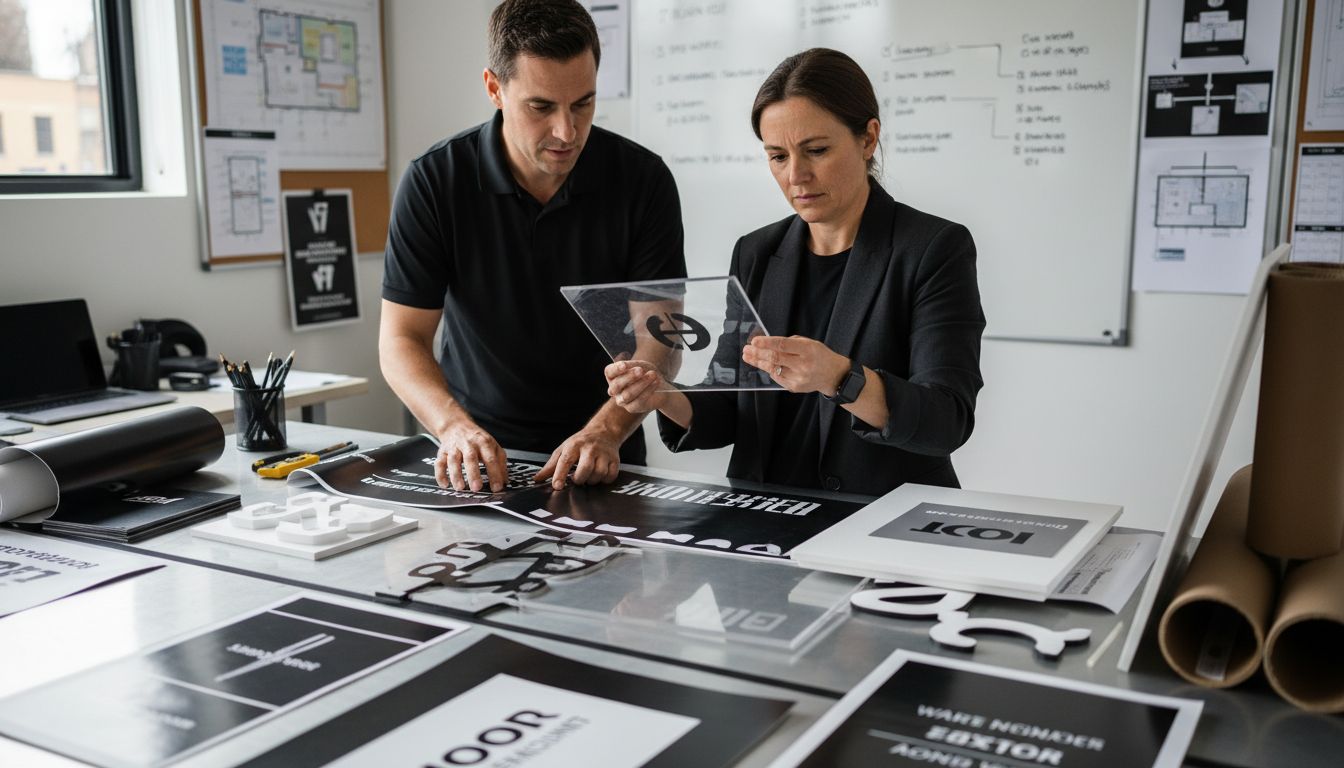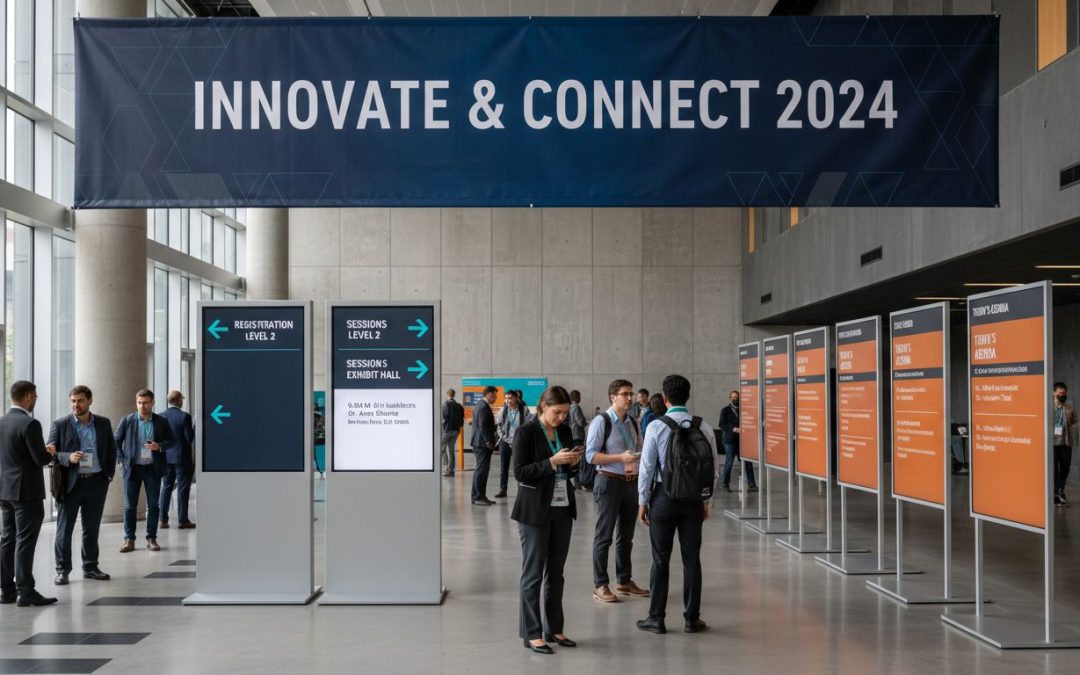{
“@type”: “Article”,
“author”: {
“url”: “https://customsignstoday.us”,
“name”: “Customsignstoday”,
“@type”: “Organization”
},
“@context”: “https://schema.org”,
“headline”: “How to Design Event Signage for Maximum Impact”,
“publisher”: {
“url”: “https://customsignstoday.us”,
“name”: “Customsignstoday”,
“@type”: “Organization”
},
“inLanguage”: “en”,
“articleBody”: “Learn how to design event signage step by step, from planning to final checks. Perfect for organizers and businesses seeking standout results.”,
“description”: “Learn how to design event signage step by step, from planning to final checks. Perfect for organizers and businesses seeking standout results.”,
“datePublished”: “2025-11-17T02:40:44.876Z”
}
Event signage can shape the entire experience at a conference or festival, yet over 60 percent of attendees say unclear signs have led them to miss information or sessions. Clear goals and audience insight turn signs into powerful tools for communication and brand impact. This guide will show you practical steps to create signage that resonates, engages, and guides your audience from the moment they arrive.
Table of Contents
- Step 1: Define Event Signage Goals And Audience
- Step 2: Choose Suitable Formats And Materials
- Step 3: Craft Clear Messaging And Branding
- Step 4: Design Visually Engaging Sign Layouts
- Step 5: Proof And Test Event Signage For Clarity
- Step 6: Coordinate Production And Installation
Quick Summary
| Key Point | Explanation |
|---|---|
| 1. Define clear goals and audience | Understand your event’s purpose and target demographics to make effective signage decisions. |
| 2. Select appropriate materials | Choose durable and legible materials based on the event environment and display requirements. |
| 3. Craft concise messaging | Ensure signage conveys key information quickly and maintains a consistent visual identity. |
| 4. Design engaging layouts | Use visual hierarchy and contrast to create compelling, easy-to-read sign layouts. |
| 5. Proof and test signage | Conduct thorough checks for clarity and readability to avoid errors before installation. |
Step 1: Define event signage goals and audience
Successful event signage starts with crystal clear goals and a deep understanding of your target audience. According to the University of Nebraska at Kearney, identifying your event’s core purpose and primary audience is fundamental to creating impactful visual communication.
Begin by asking yourself key strategic questions about your event: What specific message are you trying to convey? Who needs to receive this information? Are you aiming to direct attendees, provide critical details, create excitement, or achieve multiple objectives? For professional events, your signage goals might range from wayfinding and scheduling to branding and creating a memorable experience. At the same time, understanding your audience demographics becomes crucial selecting the right design approach language style and visual elements that will resonate most effectively.
A helpful pro tip is to create a simple audience persona worksheet. Map out key characteristics like age range professional background interests and potential information needs. This exercise will transform abstract goals into concrete design decisions ensuring your event signage speaks directly to the people who matter most.
Outdoor Event Signage Guide can provide additional insights into creating targeted visual communication strategies.
Step 2: Choose suitable formats and materials
Selecting the right formats and materials for your event signage can make or break its effectiveness. According to the University of Greenwich, the key is to ensure your content remains concise and highly legible across different display mediums.
Your material selection should align with the event environment and expected usage. For indoor corporate events consider options like acrylic panels vinyl banners printed foam boards or digital displays. Outdoor events require more durable materials such as weatherproof coroplast aluminum or high grade vinyl that can withstand environmental challenges. The University of Nebraska at Kearney recommends using high resolution images in landscape orientation with a 16:9 aspect ratio to maximize visual impact.
A pro tip is to always request material samples and conduct a quick durability test. Hold the sample up to light check its thickness and test how it responds to potential environmental conditions. This small step can prevent last minute signage failures.
 When selecting formats consider factors like portability installation ease visibility from different angles and alignment with your overall event aesthetic.
When selecting formats consider factors like portability installation ease visibility from different angles and alignment with your overall event aesthetic.
 Understanding Types of Promotional Signage can provide additional insights into matching materials with your specific event requirements.
Understanding Types of Promotional Signage can provide additional insights into matching materials with your specific event requirements.
Step 3: Craft clear messaging and branding
Crafting clear messaging and consistent branding transforms ordinary event signage into powerful communication tools. According to the University of Nebraska at Kearney, effective signage hinges on including essential event details while maintaining a cohesive visual identity.
Start by developing a strategic messaging framework that communicates your event’s core purpose quickly and memorably. Your messaging should answer key questions in seconds: What is the event? When and where is it happening? Who should attend? Use bold typography hierarchy to guide viewers eyes precisely where you want them to look. Color selection becomes critical select a palette that aligns with your brand or event theme while ensuring maximum readability. The University of Greenwich recommends keeping content concise and avoiding cluttered designs that might overwhelm your audience.
A pro tip is to create a consistent visual language across all your signage elements. This means maintaining similar fonts color schemes and graphic treatments that reinforce your brand identity. Develop a quick style guide that all signage designers can reference ensuring visual consistency. How to Design Custom Signs for Impactful Visual Branding offers additional strategies for creating memorable visual communication that resonates with your target audience.
Step 4: Design visually engaging sign layouts
Creating visually compelling sign layouts is an art form that balances aesthetic appeal with clear communication. According to the University of Nebraska at Kearney, strategic design begins with selecting high resolution images in landscape orientation with a 16:9 aspect ratio to maximize visual impact.
The foundation of an engaging layout is a thoughtful hierarchy of information. Start by establishing a clear visual flow that guides viewers eyes naturally through the most important details. Use size contrast to emphasize key information larger text for headlines smaller text for supporting details. The University of Greenwich recommends creating significant contrast between background and text colors to ensure maximum legibility. Consider using white space strategically to prevent visual clutter and allow critical information to breathe.
A pro tip is to create visual interest through asymmetrical balance. Instead of centering everything rigidly experiment with off center designs that create dynamic tension. Use graphic elements like arrows icons or geometric shapes to subtly guide viewer attention. How to Design Business Signs That Boost Visibility can provide additional techniques for creating layouts that not only look great but effectively communicate your message.
Step 5: Proof and test event signage for clarity
Proofing and testing event signage is your final quality control checkpoint before deploying your visual communication strategy. According to the University of Greenwich, reviewing digital signage content requires a meticulous approach to ensure messages are concise and easily readable from various distances.
Develop a systematic proofreading process that goes beyond simple spell checking. Read your signage content backwards to catch spelling errors look for grammatical mistakes and verify all critical details like dates times locations and contact information. The University of Nebraska at Kearney emphasizes the importance of including essential event details accurately. Create a comprehensive checklist that covers typography spacing color contrast and overall visual hierarchy. Test your signage by viewing it from multiple angles and distances simulating real world viewing conditions to ensure optimal readability.
A pro tip is to conduct a fresh eyes review by asking colleagues or a small focus group to review your signage without context. Their unbiased perspective can reveal clarity issues you might have overlooked. Pay attention to their initial reactions and comprehension speed. Outdoor Event Signs Guide can offer additional strategies for ensuring your signage communicates effectively under various environmental conditions.
Step 6: Coordinate production and installation
Coordinating production and installation transforms your signage design from concept to reality. According to the American University in Cairo, successful event execution requires a consolidated and systematic approach to managing multiple production elements simultaneously.
Begin by creating a detailed production timeline that maps out every step from design approval to final installation. Schedule buffer time for potential revisions or unexpected challenges. Contact your sign production team early and provide them with precise specifications including exact dimensions materials color specifications and digital design files. The University of Greenwich recommends ensuring all digital content meets technical requirements and copyright guidelines before submission.
A pro tip is to develop a comprehensive installation checklist that covers every potential scenario. Include details like mounting hardware required installation surfaces potential obstructions and backup plans for different environments. Walk through the installation location beforehand to identify any potential challenges. Outdoor Signage Installation Guide can provide additional insights into managing complex installation scenarios and ensuring your signage looks perfect in its final location.
Elevate Your Event Signage for Unforgettable Impact
Designing event signage that truly engages your audience takes more than good ideas. It requires clear goals, durable materials, and visually striking layouts that speak directly to your attendees. If you are striving to overcome common challenges like unclear messaging or poor visibility, Uncategorized – offers expert insights and custom solutions crafted to bring your event to life. Whether you need banners, vinyl displays, or directional signs tailored to your unique event space, we provide high-quality materials designed to withstand indoor and outdoor use.

Unlock the full potential of your event signage now by partnering with a professional team ready to transform your concepts into vibrant, effective visuals. Visit Custom Signs Today and discover how easy it is to get personalized quotes for your custom signage needs. Don’t let your message get lost in the crowd. Take the first step to make your event unforgettable today.
Frequently Asked Questions
How do I define my event signage goals and target audience?
Start by identifying the core purpose of your event and who your audience is. Create an audience persona worksheet that includes characteristics like age range and interests to ensure your signage resonates effectively.
What materials should I consider for indoor versus outdoor event signage?
For indoor events, use materials like acrylic panels or vinyl banners that are visually appealing, while outdoor signage requires durable options like weatherproof coroplast or aluminum. Identify the environment and user needs to select materials that will withstand specific conditions.
How can I ensure my event signage messaging is clear and effective?
Craft your messaging to answer key event details such as what, when, where, and who within seconds. Use bold typography and a cohesive visual identity to catch attention and communicate effectively.
What design elements are important for visually engaging sign layouts?
Focus on creating a clear visual hierarchy to guide the viewer’s eye through important information. Utilize high-resolution images, adequate white space, and contrasting text to improve legibility and interest.
What is the best way to proof and test my event signage?
Establish a systematic proofreading process that checks for spelling, grammatical errors, and all essential event details. Test the signage from various angles and distances to ensure clarity before the event.
How do I effectively coordinate the production and installation of my event signage?
Create a detailed production timeline that includes all steps from design approval to installation. Develop a checklist for installation to preemptively address potential challenges in the setup process.

